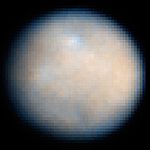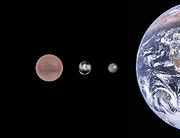
Colonization of Ceres
Encyclopedia

Space colonization
Space colonization is the concept of permanent human habitation outside of Earth. Although hypothetical at the present time, there are many proposals and speculations about the first space colony...
in the inner Solar System
Solar System
The Solar System consists of the Sun and the astronomical objects gravitationally bound in orbit around it, all of which formed from the collapse of a giant molecular cloud approximately 4.6 billion years ago. The vast majority of the system's mass is in the Sun...
.
Physical conditions
Ceres is a dwarf planetDwarf planet
A dwarf planet, as defined by the International Astronomical Union , is a celestial body orbiting the Sun that is massive enough to be spherical as a result of its own gravity but has not cleared its neighboring region of planetesimals and is not a satellite...
in the asteroid belt
Asteroid belt
The asteroid belt is the region of the Solar System located roughly between the orbits of the planets Mars and Jupiter. It is occupied by numerous irregularly shaped bodies called asteroids or minor planets...
, comprising about one third of the mass of the whole belt and being the sixth largest body in the inner Solar System by mass and volume. It has a round planet-like shape, and a surface gravitational acceleration
Gravitational acceleration
In physics, gravitational acceleration is the acceleration on an object caused by gravity. Neglecting friction such as air resistance, all small bodies accelerate in a gravitational field at the same rate relative to the center of mass....
about 2.8% that of Earth
Earth
Earth is the third planet from the Sun, and the densest and fifth-largest of the eight planets in the Solar System. It is also the largest of the Solar System's four terrestrial planets...
. It has a surface area approximately 1.9% of Earth's dry land, roughly equivalent to the area of Argentina
Argentina
Argentina , officially the Argentine Republic , is the second largest country in South America by land area, after Brazil. It is constituted as a federation of 23 provinces and an autonomous city, Buenos Aires...
. Observations indicate that it contains large amounts of water ice, about one-tenth of the total water in Earth's oceans. The solar irradiance of 150 W/m2 (in aphelion
Apsis
An apsis , plural apsides , is the point of greatest or least distance of a body from one of the foci of its elliptical orbit. In modern celestial mechanics this focus is also the center of attraction, which is usually the center of mass of the system...
), which is nine times smaller than that on Earth, is still high enough for solar-power facilities. The upcoming Juno mission
Juno (spacecraft)
Juno is a NASA New Frontiers mission to the planet Jupiter. Juno was launched from Cape Canaveral Air Force Station on August 5, 2011. The spacecraft is to be placed in a polar orbit to study the planet's composition, gravity field, magnetic field, and polar magnetosphere...
to Jupiter
Jupiter
Jupiter is the fifth planet from the Sun and the largest planet within the Solar System. It is a gas giant with mass one-thousandth that of the Sun but is two and a half times the mass of all the other planets in our Solar System combined. Jupiter is classified as a gas giant along with Saturn,...
, for example, will be relying on solar power in a location further out from the Sun than Ceres.
Strategic location
Being the largest body in the asteroid belt, Ceres could become the main base and transport hub for future asteroid miningAsteroid mining
Asteroid mining refers to the possibility of exploiting raw materials from asteroids and planetoids in space, including near-Earth objects. Minerals and volatiles could be mined from an asteroid or spent comet to provide space construction material , to extract water and oxygen to sustain the lives...
infrastructure, allowing mineral resources to be transported further to Mars
Mars
Mars is the fourth planet from the Sun in the Solar System. The planet is named after the Roman god of war, Mars. It is often described as the "Red Planet", as the iron oxide prevalent on its surface gives it a reddish appearance...
, the Moon
Moon
The Moon is Earth's only known natural satellite,There are a number of near-Earth asteroids including 3753 Cruithne that are co-orbital with Earth: their orbits bring them close to Earth for periods of time but then alter in the long term . These are quasi-satellites and not true moons. For more...
and Earth.
Its colonization also could become a step on the way to the colonization of the objects in the outer Solar System
Colonization of the outer solar system
Some of the moons of the outer planets of the solar system are large enough to be suitable places for colonization. Many of the larger moons contain water ice, liquid water, and organic compounds that might be useful for sustaining human life. Colonies in the outer Solar System could also serve as...
, such as satellites of Jupiter. Because of its small escape velocity combined with large amounts of water ice, it also could serve as a source of water, fuel and oxygen supply for ships going through and beyond the asteroid belt.
The establishment of a permanent colony on Ceres might precede colonization of the Moon
Colonization of the Moon
The colonization of the Moon is the proposed establishment of permanent human communities on the Moon. Advocates of space exploration have seen settlement of the Moon as a logical step in the expansion of humanity beyond the Earth. Recent indication that water might be present in noteworthy...
or Mars
Colonization of Mars
The colonization of Mars by humans is the focus of speculation and serious study because the surface conditions and availability of water on Mars make it arguably the most hospitable planet in the solar system other than Earth...
since the far deeper gravity wells of those bodies add dramatically to the cost and risk of colonization. As a consequence of a greater semi-major axis, Ceres has much more frequent launch windows to/from Cislunar space than to/from Mars (the synodic period is 1 year 3.3 months compared to 2 years 1.6 months), and a Hohmann transfer takes 1 year and 3.5 months. It is more energy-efficient to transport resources from the Moon or Mars to Ceres, than from Earth. In fact, transportation from Mars or the Moon to Ceres is more energy-efficient than even transportation from Earth to the Moon.
Potential difficulties


- Colonies and spacecraft face increased risk of collisions by asteroids.
- Ceres has no magnetic fieldMagnetic fieldA magnetic field is a mathematical description of the magnetic influence of electric currents and magnetic materials. The magnetic field at any given point is specified by both a direction and a magnitude ; as such it is a vector field.Technically, a magnetic field is a pseudo vector;...
. - An atmosphereAtmosphereAn atmosphere is a layer of gases that may surround a material body of sufficient mass, and that is held in place by the gravity of the body. An atmosphere may be retained for a longer duration, if the gravity is high and the atmosphere's temperature is low...
has not been detected on Ceres. - Ceres receives relatively little solar radiation.
- Delta-v budgetDelta-v budgetIn the astrodynamics and aerospace industry, a delta-v budget is the estimated delta-v requirements for the various propulsive tasks and orbital maneuvers over one or more phases of a space mission.Sample delta-v budget will enumerate various classes of maneuvers, delta-v per maneuver, number of...
to/from cislunar space is rather higher than to Mars.

